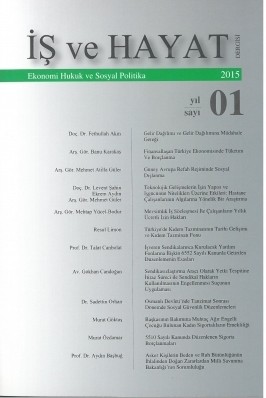Evde Yaşayan Öğrenci ile Yurtta Yaşayan Öğrencinin Yaşam Doyum Düzeylerinin Yapısal Eşitlik Modeli ile Analizi
Bu çalışmada evde yaşayan öğrenci ile yurtta yaşayan öğrencilerin yaşam doyum düzeyleri son yıllarda sık kullanılmaya başlanan yapısal eşitlik modeli ile analizi yapılmıştır. Analizin yapıldığı dönem 2015 bahar ders dönemidir. Örneklem olarak belirlenen öğrenci sayısı 208’dir, meslek yüksekokulunda aktif olarak öğrenci sayısı 850’ye yakındır. Öğrencilerin ekonomik durum algısı, fiziksel sağlık algısı, ruhsal sağlık algısı, kişiler arası ilişki algısı, yaşam kalitesi algısı ve kalınan yerden memnuniyet algısı iyi, normal ve kötü olarak ölçülmüş ve frekans dağılımları üzerinden değerlendirilmiştir. Değerlendirme neticesinde bu algıların evde yaşayan öğrencilerin “iyi” değerlendirmeleri daha yüksek çıkmıştır. Evde ve yurtta kalan öğrencilerin olumlu duyguları her iki grup için dört ifade ile, olumsuz duygular ise altı ifade ile likert beşli ölçüm modeli ile ölçülmüştür. Bu ifadelere birinci ve ikinci düzey yapısal eşitlik modeli ile doğrulayıcı faktör analizi(DFA) uygulanmış ve özellikle ikinci düzey DFA analizinde olumsuz duyguların yurtta yaşayan öğrencinin, evde yaşayan öğrenciye göre daha yüksek düzeyde yordadaığı anlaşılmıştır. Evde yaşayan öğrenci için olumsuz durumların artmış olması onun yaşam doyumunu çok fazla etkilememektedir.
Anahtar Kelimeler:
Öğrenci, Yaşam Doyum, Yapısal Eşitlik Modeli
THE ANALYSIS OF LIFE SATISFACTION LEVEL OF THE STUDENTS LIVING AT HOME OR AT DORMITORY WITH THE STRUCTURAL EQUATION MODELING
In this study, Life satisfaction level of the students who are staying at home and the ones staying at dormitory has been analyzed with the structural equation modeling which has been used frequently in recent years. The time when the analysis is done is spring term, 2015. The number of students which is defined as sample is 208 and the number of students in vocational school of higher education is about 850. Students’ perceptions of the economic conditions, physical health, emotional health, interpersonal relationship, life quality and the satisfaction of the place where they live are measured as “good\ normal\ bad” and evaluated via frequency distributions. The results of the evaluation show that the perceptions of evaluating “good” of students who are staying at home is more than the others. The positive feelings of students staying at home or at dormitory are mesaured with 4 statements for both groups however the negative feelings of them are measured with 6 statements using the “five point likert scale”. Second/ first level structural equation modeling with confirmatory factor analysis (CFA) are applied to these statements and it has been understood in especially second level structral equation analysis that the students who are staying at dormitory feed much more negative feelings than the ones who are staying at home.That the negative conditions are increased does not effect the life satisfaction level of the students who are staying at home too much.
Keywords:
Student, Life satisfaction level, Structural equation modeling,
- ISSN: 2547-9873
- Başlangıç: 2015
- Yayıncı: Şeker-İş Sendikası
Sayıdaki Diğer Makaleler
Türk Romanında Emekçilerin Varlığı Üzerine Bir İnceleme
Türkiye'nin Mülteci Sorunu ve Suriye Krizinin Mülteci Sorununa Etkileri
Ali Kemal NURDOĞAN, Ali İhsan Burak DUR, Mustafa ÖZTÜRK
Sendikal İçi Demokrasinin Sağlanmasında 6356 Sayılı Sendikalar ve Toplu İş Sözleşmesi Kanunu
Kıdem Esas Alındığında Ücret Sistemleri ve Özellikleri
Sağlık Hizmetlerine Yönelik Talebin Belirleyicileri: Türkiye Üzerine Bir Uygulama
Sıtkıcan SARAÇOĞLU, Fahriye ÖZTÜRK
Çağdaş Göç Teorileri Üzerine Bir Değerlendirme
Toplu İş Sözleşmesi Yapma Yetkisindeki Temel Sorunlar ve Sendikal Haklara Olumsuz Etkisi
